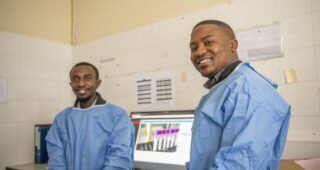24. Technology Evens the Odds for Kenya’s Health Workers Fighting HIV

HIV/AIDS is the number one cause of infant mortality in Homabay County, Kenya. In 2013, more than 4,500 children in Homabay died due to AIDS-related illnesses.
For the health workers in Homabay, Kenya, medical records are more than a filing system: they are a matter of life or death. With EGPAF’s support, a new electronic medical record (EMR) system is making it easier for health care workers to reach people living with HIV and provide timely treatment and care.
EGPAF is working with Kenya’s Ministry of Health to bring those numbers down as quickly as possible. The USAID-funded Pamoja project works to decentralize and integrate services in the health facilities that dot Homabay. Families affected by HIV are able to access services at their local clinics instead of traveling miles to the county hospital.
But scaling up HIV care and treatment is not enough without easy access to patient data — information about health status, HIV testing and treatment, outcomes of treatment and adherence to medication. Until recently, that data has been bound within unwieldy paper ledgers.
The limitations of such a system are apparent. Patients to the Kandiege subdistrict hospital, for instance, used to be tracked via hand-written entries in as many as six different large ledgers. This resulted in errors or failure to follow-up with patients who had begun treatment, according to Doreen Agina (pictured), the clinician in charge of HIV patient support at that location. Agina says that she had to physically count the number of patients on the pages and cross-reference the registers to generate a report.
Tracking patients became a lot easier for Agina in July 2013, when EGPAF helped introduce an EMR system at the Kandiege hospital, which treats more than 1,500 patients with antiretroviral medications. “We enter HIV patients’ data into a profile created on the computer and update the information every time the patient makes a visit,” says Agina.
In the past, whenever a patient lost her appointment card, which contains the patient’s record number, staff could not provide her with complete health services because they did not know her medical history. “With the EMR, using just the patient’s number, everything you need to know on that patient is displayed,” Angina says. Whenever there is a problem with a patient’s file “the system will alert you by flashing a message on the screen indicating the specific issue that needs to be addressed.”
In addition, the EMR system provides key healthindicators such as weight loss, when a CD4 test is due, or even whether a patient has missed any appointments, according to Davies Kimanga, EGPAF’s director of strategic information in Kenya.
One of the most startling bits of data provided by the new system is the number of patients accessing services. “Before EMR, we thought we were serving 3,000 HIV patients, only to discover we had about half that number,” says Agina.
For the patients in Homabay, medical records are more than a filing system: they are a matter of life or death. As EMR expands across the health system of Homabay, EGPAF staff expects the transmission of HIV and AIDS-related deaths to decrease.
Because an AIDS-free generation is not just a dream, from November 24 through December 26 we are highlighting 25 ways that EGPAF, our partners, and every-day people are helping and/or can help make it a reality. Pediatric HIV/AIDS is solvable, but we can't do it alone. Each and every one of us has an important role to play.
Joyce Chimbi
Kenya
General



